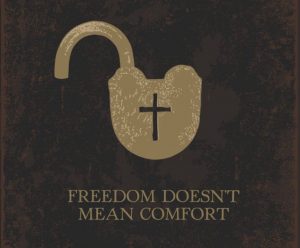All laws banning homosexual activity will be revoked. Instead legislation shall be passed which engenders love between men.…The family unit—spawning ground of lies, betrayals, mediocrity, hypocrisy and violence—will be abolished. The family unit, which only dampens imagination and curbs free will, must be eliminated. Perfect boys will be conceived and grown in the genetic laboratory. They will be bonded together in a communal setting, under the control and instruction of homosexual savants.
—Michael Swift, homosexual activist—
Key point: The fact that militant gay activists had to engage in a massive public relations campaign to entice the public to accept homosexuality as normal shows that it isn’t normal in any of the ways they claim and that same-sex couples never can have a marriage. Homosexuality may feel normal to those with same-sex attraction, but there is a better way.

The truth, Jesus said, will set you free. In following the truth, we find the way out of bondage! This is true for homosexuals and heterosexuals alike!
We move now in our series on myths that led to the recognition of same-sex marriage in America to consider two more myths, these about homosexuality.
Go here for a review of all the myths we cover in this series.
Myth #15: Homosexuality is on par with heterosexuality.
Fact: The dynamics of a heterosexual relationship—one man with one woman—stand in sharp contrast to the relationship held by two men or two women.
In an incredibly short period of time—in less than twenty short years, writes Al Mohler — “homosexuality has moved from ‘the love that dares not speak its name,’ to the center of America’s public life.” Mohler contends that this rapid and pervasive change in public attitude is attributable to one of the most successful propaganda strategies ever implemented. He’s right.
In 1987, an article titled “Overhauling Straight America” laid out a plan to win the country over to acceptance of homosexuality. It said in part,
The first order of business is desensitization of the American public concerning gays and gay rights. To desensitize the public is to help it view homosexuality with indifference instead of with keen emotion. Ideally, we would have straights register differences in sexual preference the way they register different tastes for ice cream or sports games: she likes strawberry and I like vanilla; he follows baseball and I follow football. No big deal. At least in the beginning, we are seeking public desensitization and nothing more. We do not need and cannot expect a full “appreciation” or “understanding” of homosexuality from the average American. You can forget about trying to persuade the masses that homosexuality is a good thing. But if only you can get them to think that it is just another thing, with a shrug of their shoulders, then your battle for legal and social rights is virtually won. And to get to shoulder-shrug stage, gays as a class must cease to appear mysterious, alien, loathsome and contrary. A large-scale media campaign will be required in order to change the image of gays in America. And any campaign to accomplish this turnaround should do six things:
1. Talk about gays and gayness as loudly and as often as possible
2. Portray gays as victims, not as aggressive challengers
3. Give protectors a just cause
4. Make gays look good
5. Make the victimizers look bad
6. Solicit funds: The buck stops here
You can forget about trying to persuade the masses that homosexuality is a good thing. But if only you can get them to think that it is just another thing, with a shrug of their shoulders, then your battle for legal and social rights is virtually won.
— “Overhauling Straight America,” a strategic article for gay activism written in 1987 —
You’ll have to give these public relations experts a great deal of credit. Their strategy has been more successful than even they ever could have dreamed.
Consequently, many Americans, “with a shrug of their shoulders,” do indeed see homosexuality as “another thing.” As we noted in a post dated June 30 of last year,
A new poll conducted by the Pew Research Center “found that two years after Obergefell, the Supreme Court decision that required states to recognized [sic] same-sex marriages nationwide, support for allowing gays and lesbians to marry legally is at its highest point in more than 20 years.” Among Republicans and those leaning Republican, support was essentially tied, with 48 percent opposing same-sex marriage and 47 percent favoring it. We need only go back to 2013 to find a large gap among Republicans. At that time they opposed the redefinition of marriage to include same-sex couples 61 to 33 percent!
The survey also found that while white Protestants in the evangelical tradition oppose same-sex marriage 59 to 35 percent,
younger white evangelicals have grown more supportive: 47 percent of white evangelical Millennials and Gen Xers—age cohorts born after 1964—favor same-sex marriage, up from 29 percent in March 2016.
Additionally, while African-Americans have generally been less supportive than whites of redefining marriage, since 2015 support among blacks has increased 12 points—from 39 percent to a majority—51 percent.
Overall, 62 versus 32 percent of Americans favor same-sex marriage. Contrast that to findings in 2010, when Americans opposed the idea 48 to 42 percent.
These Perceptions Don’t Fit Reality
The overwhelming success of the homosexual public relations campaign notwithstanding, stark differences between a heterosexual relationship and a homosexual one remain. In other words, these perceptions of homosexuality as “another thing” and “a good thing” simply do not square with reality. Let’s take a hard, long look at reality.
- The bodies of a husband and wife fit together. This fitting is clear to us “in the outlines of the genitalia of a male and a female. This is a fitting that obviously is not present with two men or two women. Moreover, sexual intercourse involves precisely one man and one woman. The human bodies of the man and the woman therefore point to monogamy and sexual exclusivity—and those of same sex couples point to abstinence from sexual activity altogether.”
- Only a heterosexual union can produce children. But wait! someone will say. Some heterosexual couples are childless. First, exceptions do not negate the rule, and second, childless heterosexual couples are not the same as childless same-sex couples. If a heterosexual couple cannot produce a child, there is a reason other than the fact that their relationship involves a member of each of the two sexes. We know without doubt why two men never will become parents on their own, and why two women will forever remain childless between themselves: Same-sex couples have an innate inability to produce children.
- The bodies of a husband and wife work together during sexual intercourse to enhance the probability that the wife’s egg will be fertilized by her husband’s sperm.
- When a baby arrives, the tiny boy or girl “is totally helpless. She needs nourishment on a regular basis. He needs to have his diapers changed—repeatedly. We are truly deaf and blind in the most extreme sense if we fail to see that nature’s way of bringing a new human life into the world also makes a clear and bold statement about who should have the primary responsibility to care for newborns when they arrive.” The husband and father, who is physically stronger, is better equipped to protect and provide for his wife and the children that result from their union. The wife and mother is better equipped to nurture and care for her children. This does not mean a woman never can have a career outside the home, but let’s listen to what nature says in and through a woman’s body about meeting infants’ physical needs. She and she alone can produce milk that nourishes her children. While it’s true that some women can’t produce enough milk and that some prefer to bottle-feed rather than breastfeed (the couple’s choice), this does not negate at all the natural ability that women have to feed their newborns. Alarmingly, recently a biological man made national headlines because hormone therapy had made it possible for him to breastfeed—but at significant risk to his baby. Mark it down! It is undeniable that he was not “born that way”!
- Because of the innate differences between men and women, heterosexual couples experience a relational mystery that is non-existent among same-sex couples. While homosexuals often do experience a sense of mystery with regard to their own sex or gender, the mystery of which I write here is focused on the opposite sex, and consequently, in a heterosexual relationship, on the other person. When a couple approaches this relational dynamic properly, it serves to enhance their relationship and cement their bond.
- Male-female differences can be seen in parenting styles. Children need both the strong influence of a father and the encouraging, nurturing touch of a mother.
- Natural reproduction “isn’t just about caring for babies and children so they will grow up to become responsible individuals; it’s also about maintaining a healthy society for years to come. The future of the human race depends on reproducing it so those dying out can be replaced. This can occur only with heterosexual couples. As Charles Colson put it, ‘The survival of the human race depends upon marriage as the institution by which we procreate and perpetuate civilization.’”1
- The majority opinion in the Obergefell has a strong emphasis on autonomy that stands in opposition to the selflessness and sacrifice necessary in a real marriage. Here are two examples. The ruling states, “Four principles and traditions demonstrate that the reasons marriage is fundamental under the Constitution apply with equal force to same-sex couples. The first premise of this Court’s relevant precedents is that the right to personal choice regarding marriage is inherent in the concept of individual autonomy.” The decision also says, “The fundamental liberties protected by the Fourteenth Amendment’s Due Process Clause extend to certain personal choices central to individual dignity and autonomy, including intimate choices defining personal identity and beliefs.” Again, the ruling’s emphasis on autonomy (and here we’ve cited just two examples) stands in stark contrast to the interdependency that is inherent, and inherently necessary, in a marriage, where the goal is for the two to become one. I realize that with regard to same-sex couples, we are speaking of “committed relationships.” So why is it that the ruling has to underscore individual autonomy so much? If it didn’t, it couldn’t justify making same-sex relationships eligible for marriage. Yet in doing so, the ruling contradicts one of the core principles of marriage!
- Homosexuality is associated with increased risks to one’s psychological health (also go here). Although researchers may speculate that the cause of these risks is discrimination against gays and lesbians, this trend is evident even in the most gay-friendly places.
- Homosexuality is associated with increased risks to one’s physical health. Heterosexual intercourse, obviously, is not the same as homosexual intercourse. Glenn Stanton of Focus on the Family puts it politely—but you readily can understand what he means.
One of the key reasons for the significant risk of disease and physical trauma associated with homosexuality is due to the design of human anatomy and how this anatomy is misused during homosexual sex. The bodies of two individuals who are of the same sex are not designed to be united sexually. Homosexual activity misuses parts of the body that produce no natural secretions to protect against infection and that are designed to carry out other bodily functions.
By contrast, body parts that unite in exclusive, marital, heterosexual sex were created for that activity by God. God also designed the human body so that it protects itself against abrasion and infection, and thus disease, naturally. Sexual fidelity between a husband and wife also keeps infection and disease at bay. In other words, a woman and a man were created by God for sexual union in marriage; the bodies of a husband and wife fit together.2
We therefore are back to item #1.
Another writer, Dr. Paul Cameron, doesn’t describe the situation as politely as does Mr. Stanton (also go here). Yet, we need their descriptions, because they help us more readily understand why homosexuality puts health and even life expectancies at risk.
While here we have not up to this point emphasized the biblical and theological reasons homosexuality is harmful and wrong, this perspective also is important. Go here to read an excellent article that cites biblical teachings on this matter.
Myth #16: Homosexuality is primarily an identity, not a behavior.
Fact: Despite the pervasiveness of the idea that homosexuality is an identity, it is inseparably linked to behavior. Thus, to effectively grapple with and understand homosexuality, it should be seen this way. This is not to say that we shouldn’t be sensitive to those who see themselves in terms of a gay identity, but it is to say seeing oneself in this way will hold a person unnecessarily in bondage to the gay lifestyle.
Writing for Focus on the Family, Jeff Johnston accurately observes,
Over time, the definition of homosexuality has shifted from being a behavior to a condition to an identity. In the Bible, for example, the focus is on the behavior. Scripture says don’t engage in this activity.
As Christians, we don’t want to define people by their attractions or struggle. We should look beyond homosexuality to see a person as a sacred human being created in the image of God. “Being straight” or “being gay” may be the way the culture likes to label people; however, it’s not how God determines our identity or worth. God bases our worth on His unchanging, unfailing, eternal love for us.
The idea that homosexuality legitimately can be considered an identity is reinforced if it it is natural and normal. But is it? Are individuals really “born that way”? I’d like to answer this question from three different angles.
First, in an important sense, everyone is “born that way” — meaning born with a pull to live apart from God and to do whatever he or she wants to do. Just ask Emily Thomes, who was liberated when she discovered that because she was first and foremost made in God’s image, her base desires did not have to enslave her. She admits to being born with an inclination to follow sinful desires. This is indeed the natural condition of every person. BreakPoint: Your Desires Don’t Define You
Emily does not mean, however, that homosexuality is a biological trait. In fact, no “gay gene” ever has been discovered. Thus, no evidence exists that homosexuality has a purely genetic cause (go here, here, and here).
Homosexuality can legitimately be considered natural in a second sense as well. Mark it down, though! Our qualifications here are vitally important, so please read this section carefully. In the vast majority of cases, a person experiencing same-sex attraction (SSA) did not choose those desires. For some, the desires arise, and no specific environmental or experiential cause can be pinpointed. This doesn’t mean the urges are rooted solely in one’s DNA, without other influences. Just because an environmental factor can’t readily be recognized does not mean one or more aren’t present. Also, especially among the young, the cultural allure to “be gay because gay is cool” is everywhere. And while we cannot say that homosexuality is purely a choice, neither can we deny that choices—including deliberate, conscious ones—are involved. For such choices, individuals must indeed bear personal responsibility.
Perhaps an illustration will help. We readily acknowledge that in numerous instances the inclination to steal, lie, or cheat on one’s spouse is quite natural. Also, each of these feels natural. Would it be a good and healthy thing to follow through on any of these urges? No. Not everything that can be deemed natural necessarily is good!
Finally, from a third standpoint, homosexuality is unnatural because it violates God’s design for human beings, the human family, and society at large. The above list of ten items is rooted in the principle that human beings are designed a certain way, for a specific purpose. Homosexuality violates these purposes and thus produces hurtful and harmful results.
Again, it’s important to remember that we never should define people, or allow ourselves to be defined, by urges and inclinations. The identity myth does exactly this.
The identity myth defines people according to their urges and desires. This fails to treat people with the dignity and respect they deserve.
Not only did this myth, along with others, lead to Obergefell, it now reinforces it. Even so, no one has to remain in bondage to homosexual desires. Again, ask Emily Thomes. You also can ask Stephen Black, who tells his story here. Stephen is the executive director of First Stone Ministries and the author of Freedom Realized! Freedom from Homosexuality & Living a Life Free from Labels.
Don’t be taken in by the myths! Reality, in the long run, is far better! In other words, when we cooperate with reality, we find and can fulfill our God-given purpose on this earth. That purpose never involves remaining in homosexuality—even when same-sex attractions and other temptations persist.

The myths keep us in bondage, but reality—the truth in Christ—shows us the way out.
Part 10 is available here.
Copyright © 2018 by B. Nathaniel Sullivan. All rights reserved.
image credit: top image, www.lightstock.com
1Charles Colson with Anne Morse, My Final Word, (Grand Rapids: Zondervan, 2015), 142.
2Glenn Stanton, “Homosexuality: A Christian Perspective” in A Single Pursuit, Winter, 1998-99, (Nashville: LifeWay Christian Resources of the Southern Baptist Convention, 1998), 85.

Be First to Comment